Inquiry Based Learning Report: Current Retail Trends and IKEA Analysis
VerifiedAdded on 2022/12/26
|12
|2641
|64
Report
AI Summary
This report, submitted as part of an inquiry-based learning project, examines current trends in the UK retail industry, including the adoption of omni-channel strategies, personalized retail experiences, the growing culture of immediacy, and the use of mobile payment systems. The report then analyzes the business model of IKEA, exploring its value proposition, key resources, activities, partnerships, channels, customer segments, and cost structure. It further delves into IKEA's competitive strategies, such as product diversity and non-profit status. The report concludes with recommendations for IKEA's future growth, emphasizing the importance of developing a customer-centric mobile application, leveraging AI-powered personal assistants, improving payment methods, enhancing supply chain efficiency, and focusing on sustainability initiatives. These recommendations aim to help IKEA adapt to the ever-changing retail landscape and maintain its competitive edge.

FY028 Inquiry Based
Learning
Learning
Paraphrase This Document
Need a fresh take? Get an instant paraphrase of this document with our AI Paraphraser
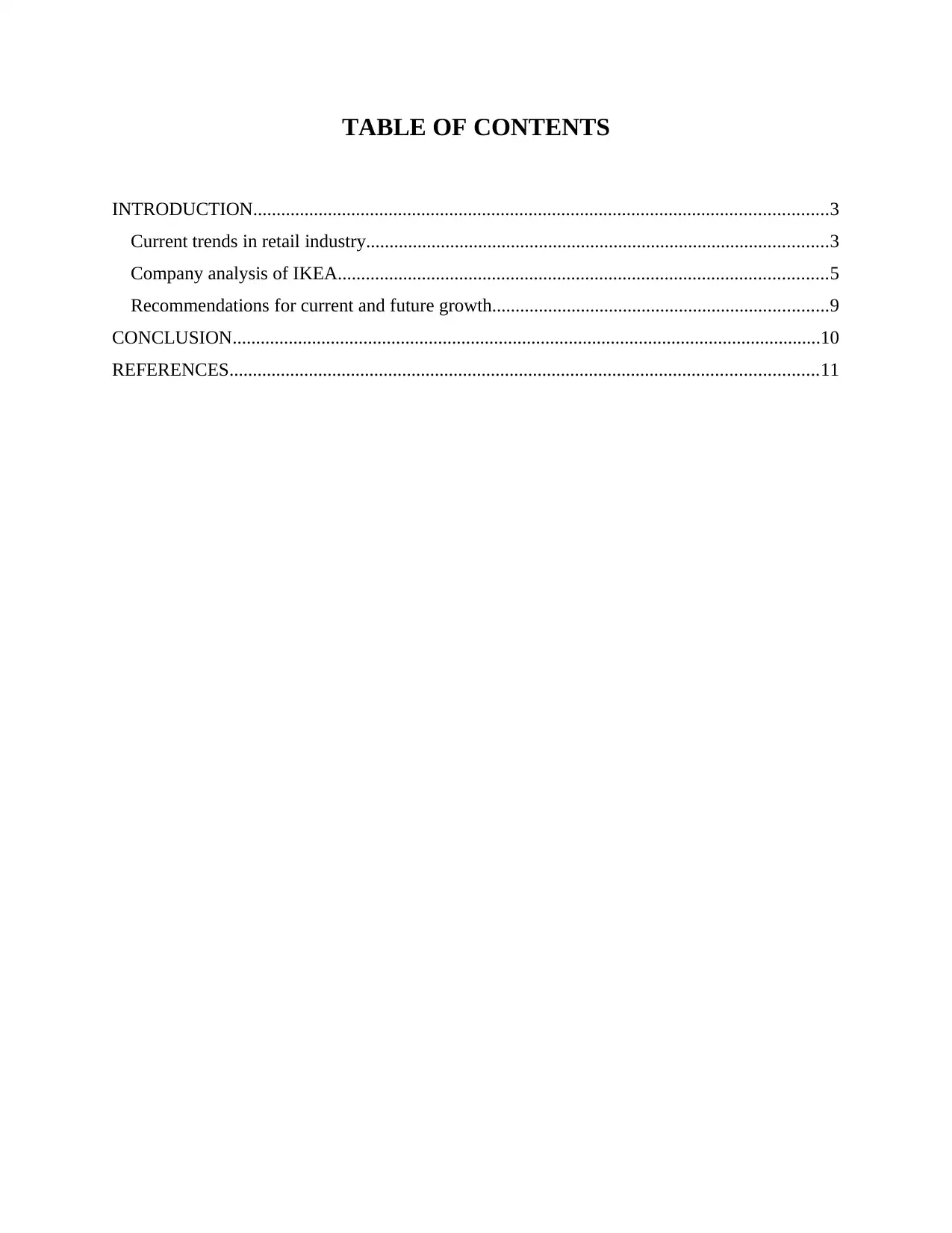
TABLE OF CONTENTS
INTRODUCTION...........................................................................................................................3
Current trends in retail industry...................................................................................................3
Company analysis of IKEA.........................................................................................................5
Recommendations for current and future growth........................................................................9
CONCLUSION..............................................................................................................................10
REFERENCES..............................................................................................................................11
INTRODUCTION...........................................................................................................................3
Current trends in retail industry...................................................................................................3
Company analysis of IKEA.........................................................................................................5
Recommendations for current and future growth........................................................................9
CONCLUSION..............................................................................................................................10
REFERENCES..............................................................................................................................11
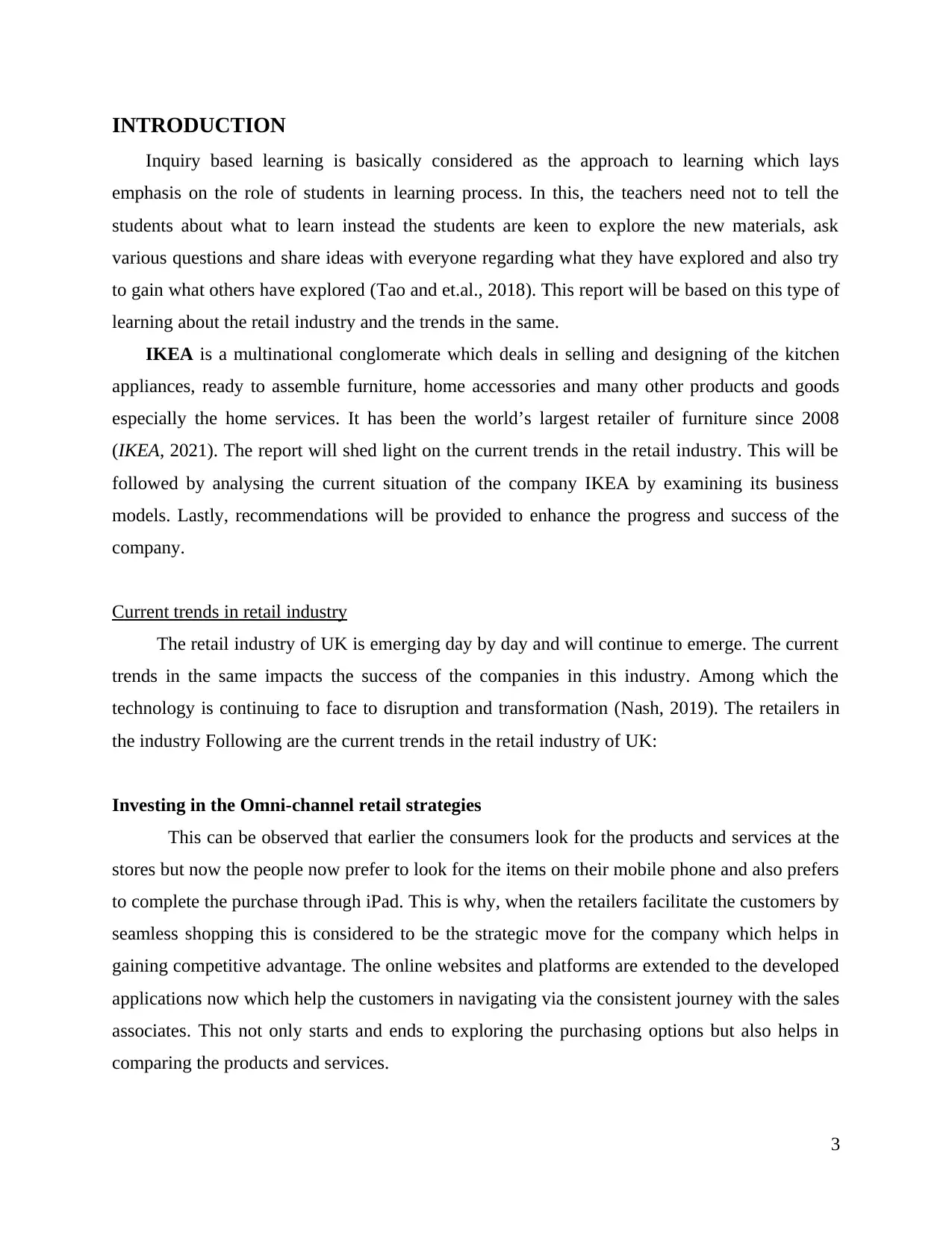
INTRODUCTION
Inquiry based learning is basically considered as the approach to learning which lays
emphasis on the role of students in learning process. In this, the teachers need not to tell the
students about what to learn instead the students are keen to explore the new materials, ask
various questions and share ideas with everyone regarding what they have explored and also try
to gain what others have explored (Tao and et.al., 2018). This report will be based on this type of
learning about the retail industry and the trends in the same.
IKEA is a multinational conglomerate which deals in selling and designing of the kitchen
appliances, ready to assemble furniture, home accessories and many other products and goods
especially the home services. It has been the world’s largest retailer of furniture since 2008
(IKEA, 2021). The report will shed light on the current trends in the retail industry. This will be
followed by analysing the current situation of the company IKEA by examining its business
models. Lastly, recommendations will be provided to enhance the progress and success of the
company.
Current trends in retail industry
The retail industry of UK is emerging day by day and will continue to emerge. The current
trends in the same impacts the success of the companies in this industry. Among which the
technology is continuing to face to disruption and transformation (Nash, 2019). The retailers in
the industry Following are the current trends in the retail industry of UK:
Investing in the Omni-channel retail strategies
This can be observed that earlier the consumers look for the products and services at the
stores but now the people now prefer to look for the items on their mobile phone and also prefers
to complete the purchase through iPad. This is why, when the retailers facilitate the customers by
seamless shopping this is considered to be the strategic move for the company which helps in
gaining competitive advantage. The online websites and platforms are extended to the developed
applications now which help the customers in navigating via the consistent journey with the sales
associates. This not only starts and ends to exploring the purchasing options but also helps in
comparing the products and services.
3
Inquiry based learning is basically considered as the approach to learning which lays
emphasis on the role of students in learning process. In this, the teachers need not to tell the
students about what to learn instead the students are keen to explore the new materials, ask
various questions and share ideas with everyone regarding what they have explored and also try
to gain what others have explored (Tao and et.al., 2018). This report will be based on this type of
learning about the retail industry and the trends in the same.
IKEA is a multinational conglomerate which deals in selling and designing of the kitchen
appliances, ready to assemble furniture, home accessories and many other products and goods
especially the home services. It has been the world’s largest retailer of furniture since 2008
(IKEA, 2021). The report will shed light on the current trends in the retail industry. This will be
followed by analysing the current situation of the company IKEA by examining its business
models. Lastly, recommendations will be provided to enhance the progress and success of the
company.
Current trends in retail industry
The retail industry of UK is emerging day by day and will continue to emerge. The current
trends in the same impacts the success of the companies in this industry. Among which the
technology is continuing to face to disruption and transformation (Nash, 2019). The retailers in
the industry Following are the current trends in the retail industry of UK:
Investing in the Omni-channel retail strategies
This can be observed that earlier the consumers look for the products and services at the
stores but now the people now prefer to look for the items on their mobile phone and also prefers
to complete the purchase through iPad. This is why, when the retailers facilitate the customers by
seamless shopping this is considered to be the strategic move for the company which helps in
gaining competitive advantage. The online websites and platforms are extended to the developed
applications now which help the customers in navigating via the consistent journey with the sales
associates. This not only starts and ends to exploring the purchasing options but also helps in
comparing the products and services.
3
⊘ This is a preview!⊘
Do you want full access?
Subscribe today to unlock all pages.

Trusted by 1+ million students worldwide
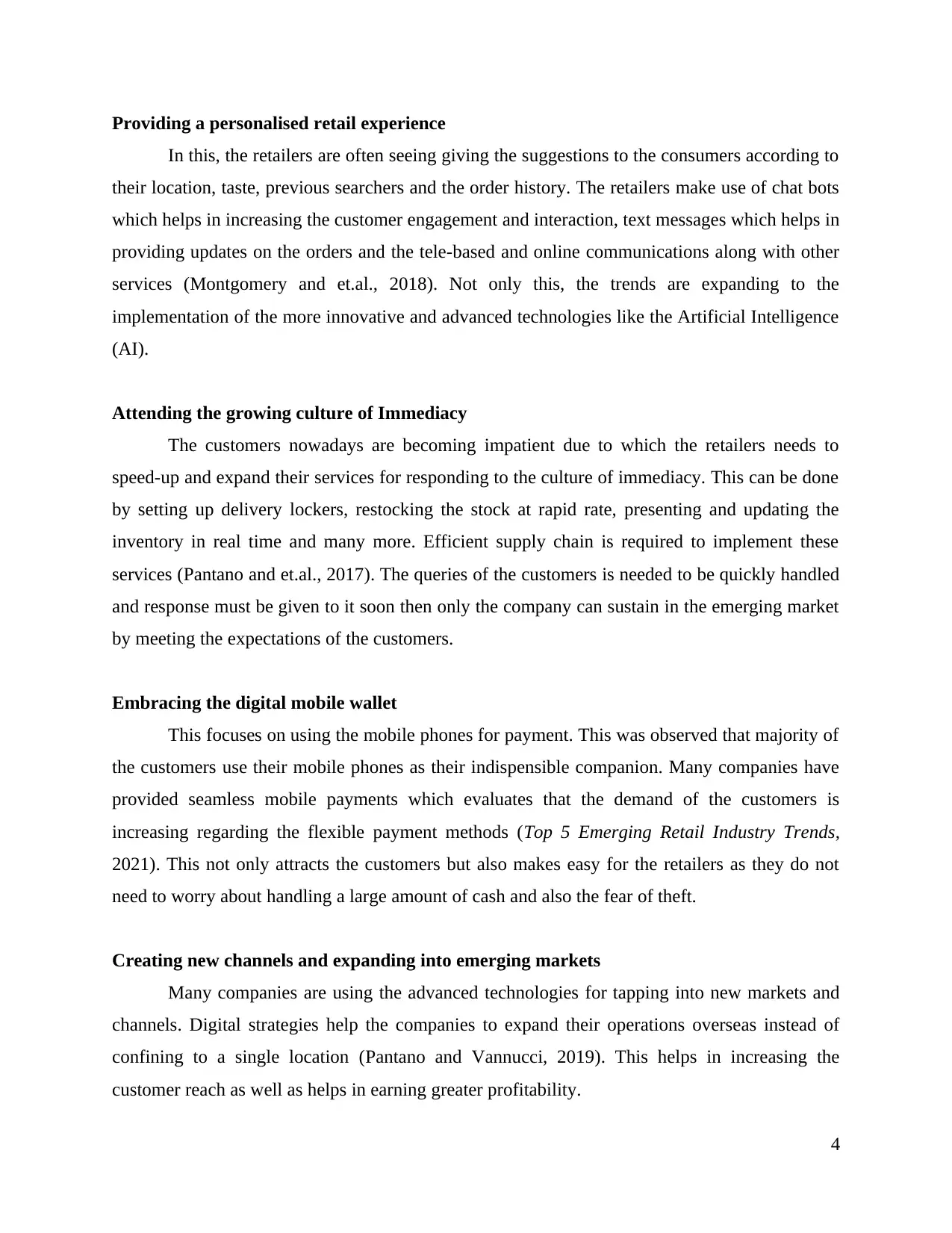
Providing a personalised retail experience
In this, the retailers are often seeing giving the suggestions to the consumers according to
their location, taste, previous searchers and the order history. The retailers make use of chat bots
which helps in increasing the customer engagement and interaction, text messages which helps in
providing updates on the orders and the tele-based and online communications along with other
services (Montgomery and et.al., 2018). Not only this, the trends are expanding to the
implementation of the more innovative and advanced technologies like the Artificial Intelligence
(AI).
Attending the growing culture of Immediacy
The customers nowadays are becoming impatient due to which the retailers needs to
speed-up and expand their services for responding to the culture of immediacy. This can be done
by setting up delivery lockers, restocking the stock at rapid rate, presenting and updating the
inventory in real time and many more. Efficient supply chain is required to implement these
services (Pantano and et.al., 2017). The queries of the customers is needed to be quickly handled
and response must be given to it soon then only the company can sustain in the emerging market
by meeting the expectations of the customers.
Embracing the digital mobile wallet
This focuses on using the mobile phones for payment. This was observed that majority of
the customers use their mobile phones as their indispensible companion. Many companies have
provided seamless mobile payments which evaluates that the demand of the customers is
increasing regarding the flexible payment methods (Top 5 Emerging Retail Industry Trends,
2021). This not only attracts the customers but also makes easy for the retailers as they do not
need to worry about handling a large amount of cash and also the fear of theft.
Creating new channels and expanding into emerging markets
Many companies are using the advanced technologies for tapping into new markets and
channels. Digital strategies help the companies to expand their operations overseas instead of
confining to a single location (Pantano and Vannucci, 2019). This helps in increasing the
customer reach as well as helps in earning greater profitability.
4
In this, the retailers are often seeing giving the suggestions to the consumers according to
their location, taste, previous searchers and the order history. The retailers make use of chat bots
which helps in increasing the customer engagement and interaction, text messages which helps in
providing updates on the orders and the tele-based and online communications along with other
services (Montgomery and et.al., 2018). Not only this, the trends are expanding to the
implementation of the more innovative and advanced technologies like the Artificial Intelligence
(AI).
Attending the growing culture of Immediacy
The customers nowadays are becoming impatient due to which the retailers needs to
speed-up and expand their services for responding to the culture of immediacy. This can be done
by setting up delivery lockers, restocking the stock at rapid rate, presenting and updating the
inventory in real time and many more. Efficient supply chain is required to implement these
services (Pantano and et.al., 2017). The queries of the customers is needed to be quickly handled
and response must be given to it soon then only the company can sustain in the emerging market
by meeting the expectations of the customers.
Embracing the digital mobile wallet
This focuses on using the mobile phones for payment. This was observed that majority of
the customers use their mobile phones as their indispensible companion. Many companies have
provided seamless mobile payments which evaluates that the demand of the customers is
increasing regarding the flexible payment methods (Top 5 Emerging Retail Industry Trends,
2021). This not only attracts the customers but also makes easy for the retailers as they do not
need to worry about handling a large amount of cash and also the fear of theft.
Creating new channels and expanding into emerging markets
Many companies are using the advanced technologies for tapping into new markets and
channels. Digital strategies help the companies to expand their operations overseas instead of
confining to a single location (Pantano and Vannucci, 2019). This helps in increasing the
customer reach as well as helps in earning greater profitability.
4
Paraphrase This Document
Need a fresh take? Get an instant paraphrase of this document with our AI Paraphraser
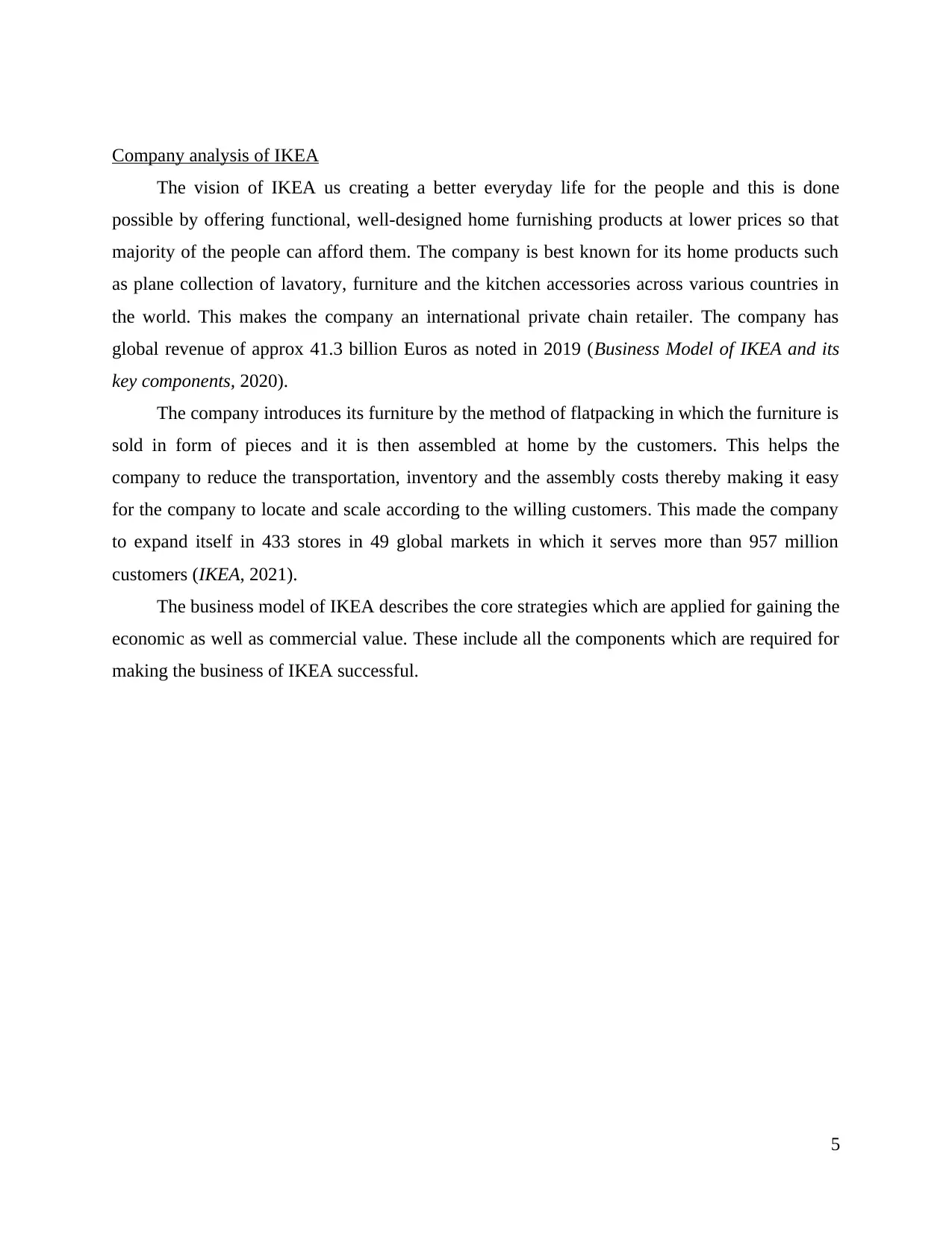
Company analysis of IKEA
The vision of IKEA us creating a better everyday life for the people and this is done
possible by offering functional, well-designed home furnishing products at lower prices so that
majority of the people can afford them. The company is best known for its home products such
as plane collection of lavatory, furniture and the kitchen accessories across various countries in
the world. This makes the company an international private chain retailer. The company has
global revenue of approx 41.3 billion Euros as noted in 2019 (Business Model of IKEA and its
key components, 2020).
The company introduces its furniture by the method of flatpacking in which the furniture is
sold in form of pieces and it is then assembled at home by the customers. This helps the
company to reduce the transportation, inventory and the assembly costs thereby making it easy
for the company to locate and scale according to the willing customers. This made the company
to expand itself in 433 stores in 49 global markets in which it serves more than 957 million
customers (IKEA, 2021).
The business model of IKEA describes the core strategies which are applied for gaining the
economic as well as commercial value. These include all the components which are required for
making the business of IKEA successful.
5
The vision of IKEA us creating a better everyday life for the people and this is done
possible by offering functional, well-designed home furnishing products at lower prices so that
majority of the people can afford them. The company is best known for its home products such
as plane collection of lavatory, furniture and the kitchen accessories across various countries in
the world. This makes the company an international private chain retailer. The company has
global revenue of approx 41.3 billion Euros as noted in 2019 (Business Model of IKEA and its
key components, 2020).
The company introduces its furniture by the method of flatpacking in which the furniture is
sold in form of pieces and it is then assembled at home by the customers. This helps the
company to reduce the transportation, inventory and the assembly costs thereby making it easy
for the company to locate and scale according to the willing customers. This made the company
to expand itself in 433 stores in 49 global markets in which it serves more than 957 million
customers (IKEA, 2021).
The business model of IKEA describes the core strategies which are applied for gaining the
economic as well as commercial value. These include all the components which are required for
making the business of IKEA successful.
5
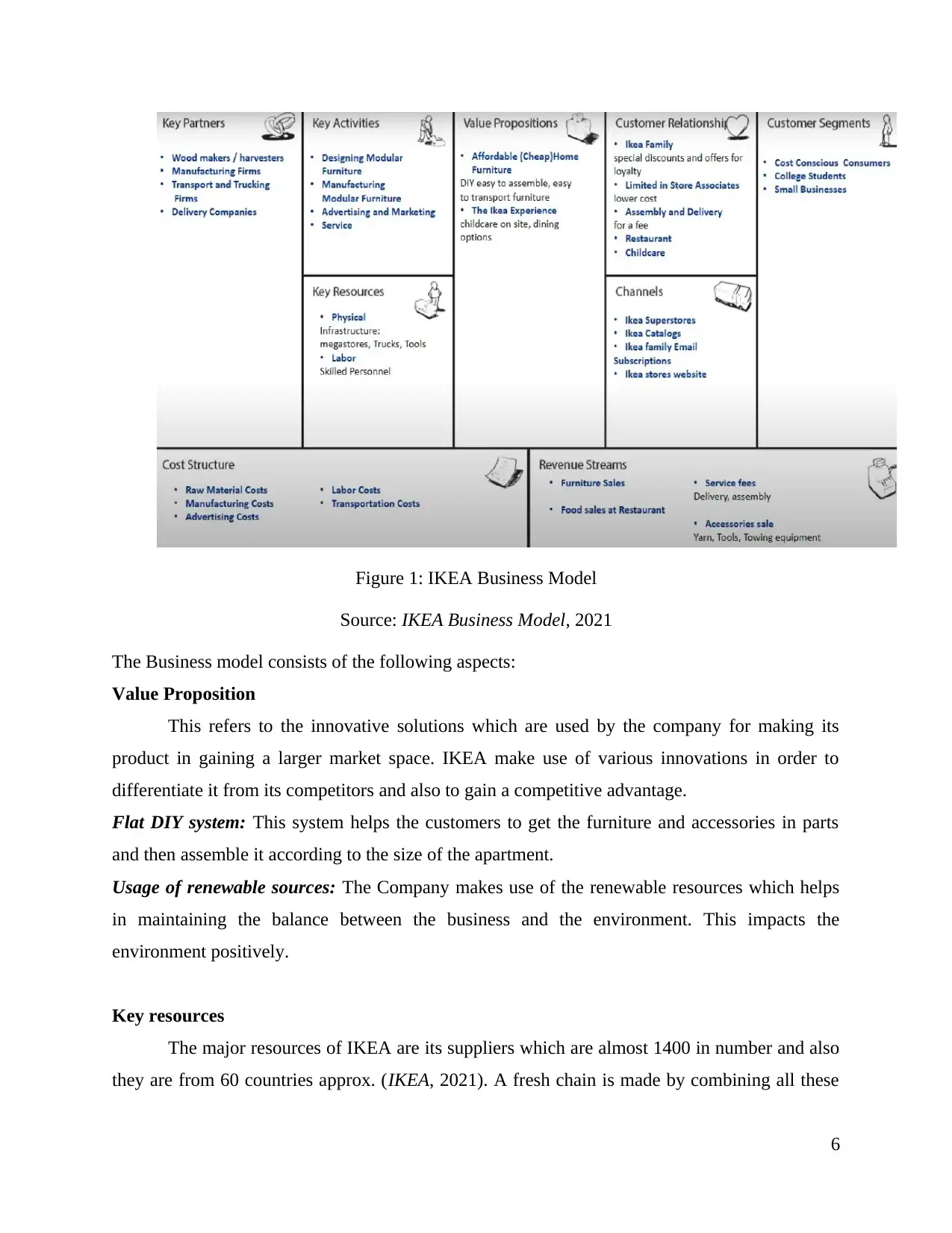
Figure 1: IKEA Business Model
Source: IKEA Business Model, 2021
The Business model consists of the following aspects:
Value Proposition
This refers to the innovative solutions which are used by the company for making its
product in gaining a larger market space. IKEA make use of various innovations in order to
differentiate it from its competitors and also to gain a competitive advantage.
Flat DIY system: This system helps the customers to get the furniture and accessories in parts
and then assemble it according to the size of the apartment.
Usage of renewable sources: The Company makes use of the renewable resources which helps
in maintaining the balance between the business and the environment. This impacts the
environment positively.
Key resources
The major resources of IKEA are its suppliers which are almost 1400 in number and also
they are from 60 countries approx. (IKEA, 2021). A fresh chain is made by combining all these
6
Source: IKEA Business Model, 2021
The Business model consists of the following aspects:
Value Proposition
This refers to the innovative solutions which are used by the company for making its
product in gaining a larger market space. IKEA make use of various innovations in order to
differentiate it from its competitors and also to gain a competitive advantage.
Flat DIY system: This system helps the customers to get the furniture and accessories in parts
and then assemble it according to the size of the apartment.
Usage of renewable sources: The Company makes use of the renewable resources which helps
in maintaining the balance between the business and the environment. This impacts the
environment positively.
Key resources
The major resources of IKEA are its suppliers which are almost 1400 in number and also
they are from 60 countries approx. (IKEA, 2021). A fresh chain is made by combining all these
6
⊘ This is a preview!⊘
Do you want full access?
Subscribe today to unlock all pages.

Trusted by 1+ million students worldwide
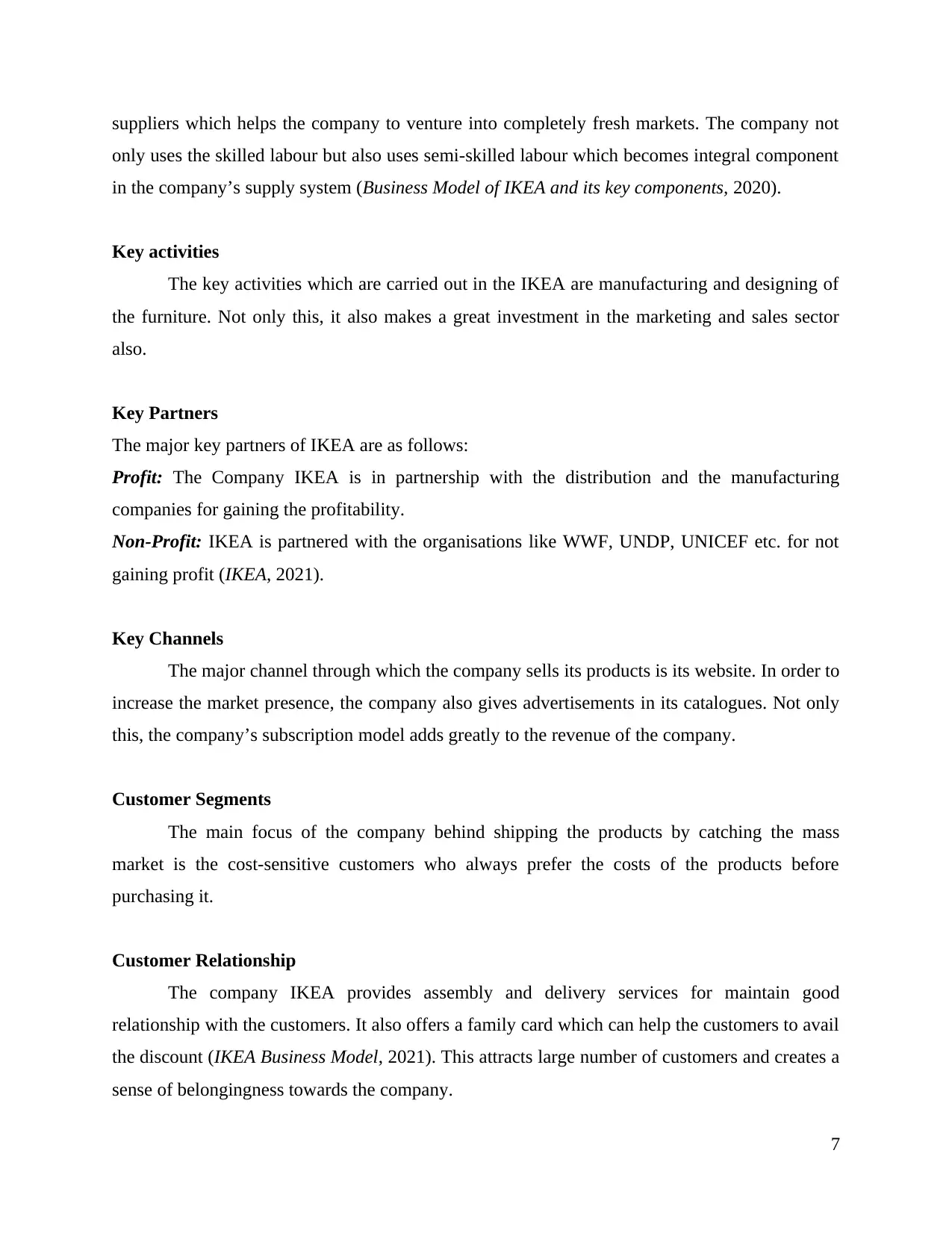
suppliers which helps the company to venture into completely fresh markets. The company not
only uses the skilled labour but also uses semi-skilled labour which becomes integral component
in the company’s supply system (Business Model of IKEA and its key components, 2020).
Key activities
The key activities which are carried out in the IKEA are manufacturing and designing of
the furniture. Not only this, it also makes a great investment in the marketing and sales sector
also.
Key Partners
The major key partners of IKEA are as follows:
Profit: The Company IKEA is in partnership with the distribution and the manufacturing
companies for gaining the profitability.
Non-Profit: IKEA is partnered with the organisations like WWF, UNDP, UNICEF etc. for not
gaining profit (IKEA, 2021).
Key Channels
The major channel through which the company sells its products is its website. In order to
increase the market presence, the company also gives advertisements in its catalogues. Not only
this, the company’s subscription model adds greatly to the revenue of the company.
Customer Segments
The main focus of the company behind shipping the products by catching the mass
market is the cost-sensitive customers who always prefer the costs of the products before
purchasing it.
Customer Relationship
The company IKEA provides assembly and delivery services for maintain good
relationship with the customers. It also offers a family card which can help the customers to avail
the discount (IKEA Business Model, 2021). This attracts large number of customers and creates a
sense of belongingness towards the company.
7
only uses the skilled labour but also uses semi-skilled labour which becomes integral component
in the company’s supply system (Business Model of IKEA and its key components, 2020).
Key activities
The key activities which are carried out in the IKEA are manufacturing and designing of
the furniture. Not only this, it also makes a great investment in the marketing and sales sector
also.
Key Partners
The major key partners of IKEA are as follows:
Profit: The Company IKEA is in partnership with the distribution and the manufacturing
companies for gaining the profitability.
Non-Profit: IKEA is partnered with the organisations like WWF, UNDP, UNICEF etc. for not
gaining profit (IKEA, 2021).
Key Channels
The major channel through which the company sells its products is its website. In order to
increase the market presence, the company also gives advertisements in its catalogues. Not only
this, the company’s subscription model adds greatly to the revenue of the company.
Customer Segments
The main focus of the company behind shipping the products by catching the mass
market is the cost-sensitive customers who always prefer the costs of the products before
purchasing it.
Customer Relationship
The company IKEA provides assembly and delivery services for maintain good
relationship with the customers. It also offers a family card which can help the customers to avail
the discount (IKEA Business Model, 2021). This attracts large number of customers and creates a
sense of belongingness towards the company.
7
Paraphrase This Document
Need a fresh take? Get an instant paraphrase of this document with our AI Paraphraser
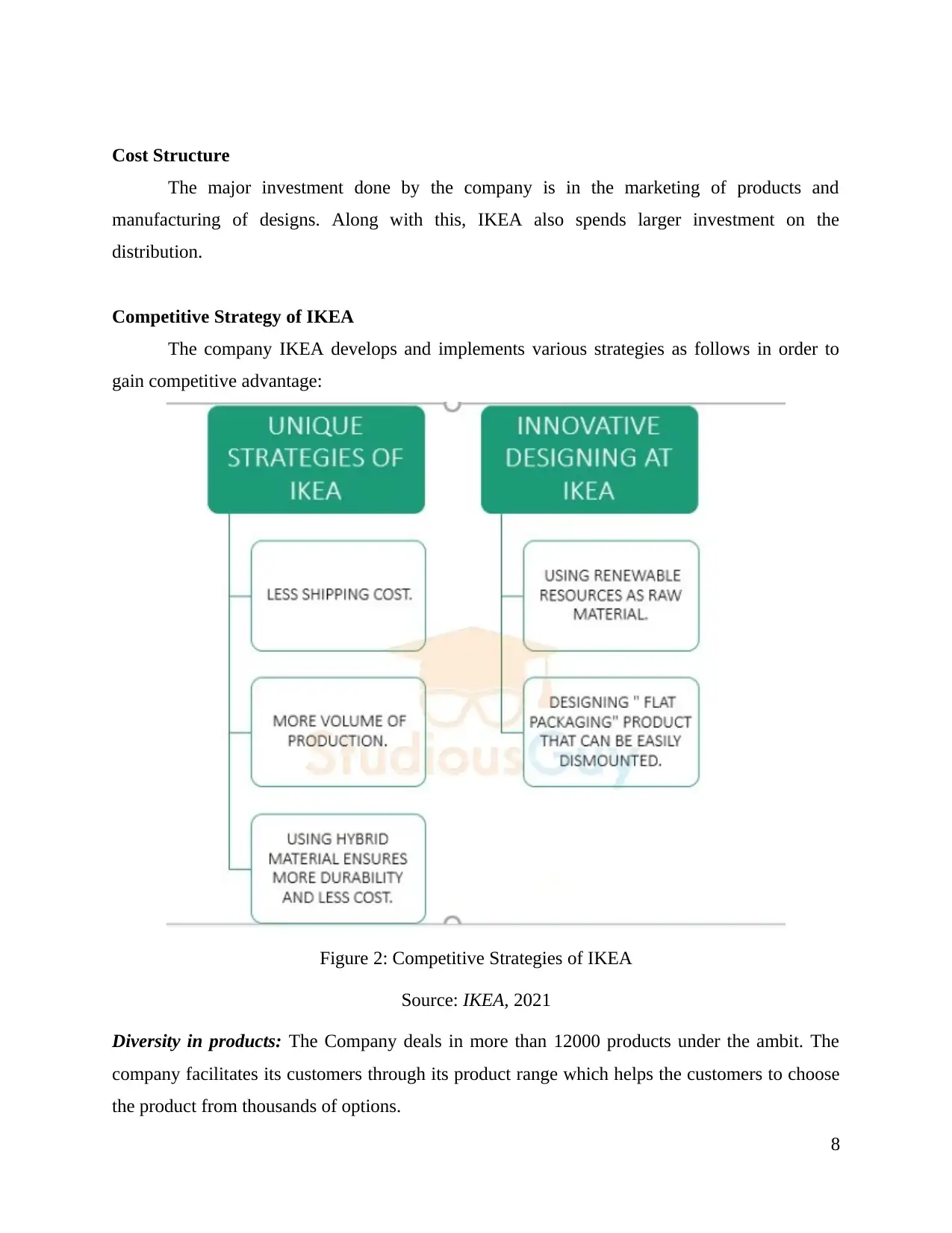
Cost Structure
The major investment done by the company is in the marketing of products and
manufacturing of designs. Along with this, IKEA also spends larger investment on the
distribution.
Competitive Strategy of IKEA
The company IKEA develops and implements various strategies as follows in order to
gain competitive advantage:
Figure 2: Competitive Strategies of IKEA
Source: IKEA, 2021
Diversity in products: The Company deals in more than 12000 products under the ambit. The
company facilitates its customers through its product range which helps the customers to choose
the product from thousands of options.
8
The major investment done by the company is in the marketing of products and
manufacturing of designs. Along with this, IKEA also spends larger investment on the
distribution.
Competitive Strategy of IKEA
The company IKEA develops and implements various strategies as follows in order to
gain competitive advantage:
Figure 2: Competitive Strategies of IKEA
Source: IKEA, 2021
Diversity in products: The Company deals in more than 12000 products under the ambit. The
company facilitates its customers through its product range which helps the customers to choose
the product from thousands of options.
8
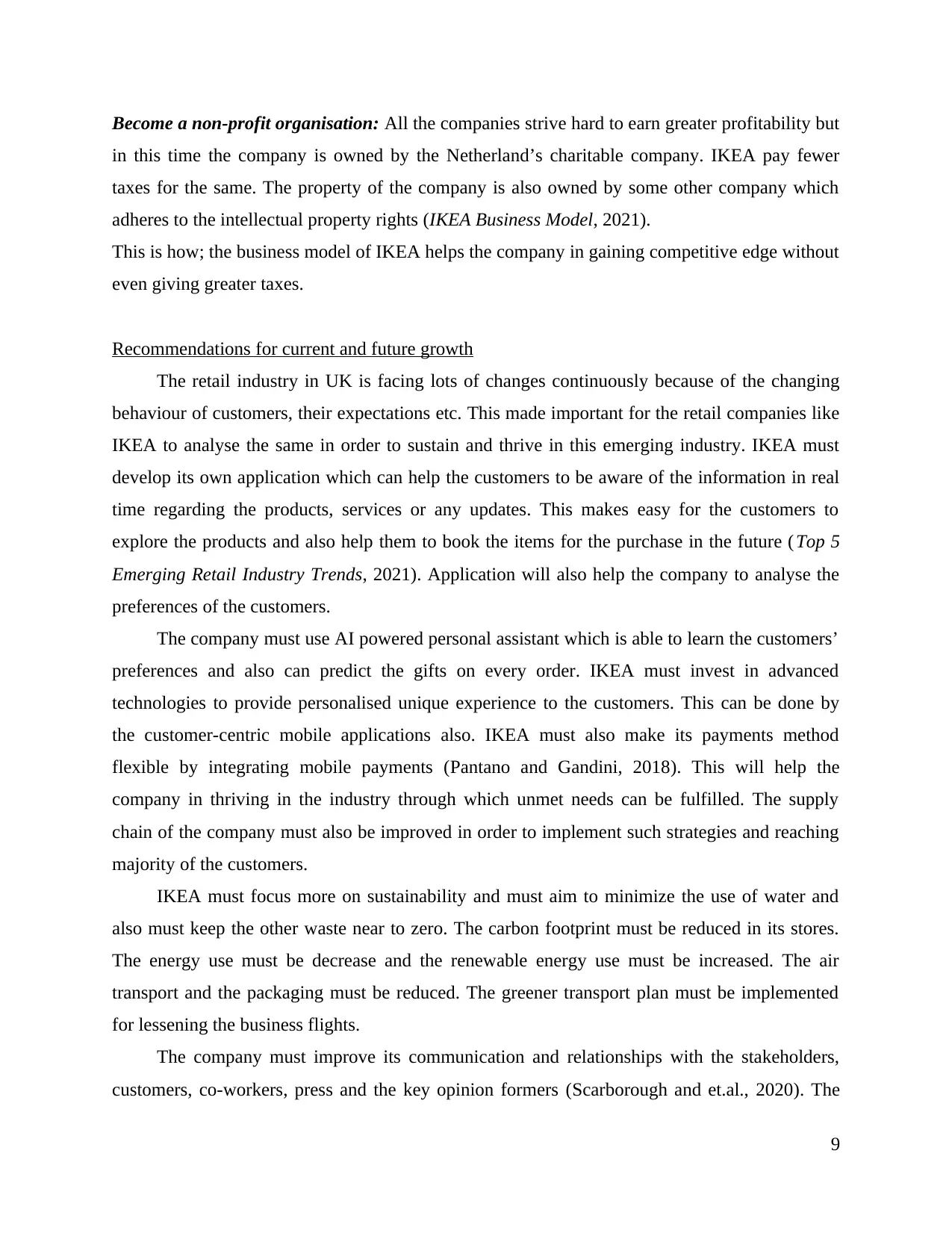
Become a non-profit organisation: All the companies strive hard to earn greater profitability but
in this time the company is owned by the Netherland’s charitable company. IKEA pay fewer
taxes for the same. The property of the company is also owned by some other company which
adheres to the intellectual property rights (IKEA Business Model, 2021).
This is how; the business model of IKEA helps the company in gaining competitive edge without
even giving greater taxes.
Recommendations for current and future growth
The retail industry in UK is facing lots of changes continuously because of the changing
behaviour of customers, their expectations etc. This made important for the retail companies like
IKEA to analyse the same in order to sustain and thrive in this emerging industry. IKEA must
develop its own application which can help the customers to be aware of the information in real
time regarding the products, services or any updates. This makes easy for the customers to
explore the products and also help them to book the items for the purchase in the future (Top 5
Emerging Retail Industry Trends, 2021). Application will also help the company to analyse the
preferences of the customers.
The company must use AI powered personal assistant which is able to learn the customers’
preferences and also can predict the gifts on every order. IKEA must invest in advanced
technologies to provide personalised unique experience to the customers. This can be done by
the customer-centric mobile applications also. IKEA must also make its payments method
flexible by integrating mobile payments (Pantano and Gandini, 2018). This will help the
company in thriving in the industry through which unmet needs can be fulfilled. The supply
chain of the company must also be improved in order to implement such strategies and reaching
majority of the customers.
IKEA must focus more on sustainability and must aim to minimize the use of water and
also must keep the other waste near to zero. The carbon footprint must be reduced in its stores.
The energy use must be decrease and the renewable energy use must be increased. The air
transport and the packaging must be reduced. The greener transport plan must be implemented
for lessening the business flights.
The company must improve its communication and relationships with the stakeholders,
customers, co-workers, press and the key opinion formers (Scarborough and et.al., 2020). The
9
in this time the company is owned by the Netherland’s charitable company. IKEA pay fewer
taxes for the same. The property of the company is also owned by some other company which
adheres to the intellectual property rights (IKEA Business Model, 2021).
This is how; the business model of IKEA helps the company in gaining competitive edge without
even giving greater taxes.
Recommendations for current and future growth
The retail industry in UK is facing lots of changes continuously because of the changing
behaviour of customers, their expectations etc. This made important for the retail companies like
IKEA to analyse the same in order to sustain and thrive in this emerging industry. IKEA must
develop its own application which can help the customers to be aware of the information in real
time regarding the products, services or any updates. This makes easy for the customers to
explore the products and also help them to book the items for the purchase in the future (Top 5
Emerging Retail Industry Trends, 2021). Application will also help the company to analyse the
preferences of the customers.
The company must use AI powered personal assistant which is able to learn the customers’
preferences and also can predict the gifts on every order. IKEA must invest in advanced
technologies to provide personalised unique experience to the customers. This can be done by
the customer-centric mobile applications also. IKEA must also make its payments method
flexible by integrating mobile payments (Pantano and Gandini, 2018). This will help the
company in thriving in the industry through which unmet needs can be fulfilled. The supply
chain of the company must also be improved in order to implement such strategies and reaching
majority of the customers.
IKEA must focus more on sustainability and must aim to minimize the use of water and
also must keep the other waste near to zero. The carbon footprint must be reduced in its stores.
The energy use must be decrease and the renewable energy use must be increased. The air
transport and the packaging must be reduced. The greener transport plan must be implemented
for lessening the business flights.
The company must improve its communication and relationships with the stakeholders,
customers, co-workers, press and the key opinion formers (Scarborough and et.al., 2020). The
9
⊘ This is a preview!⊘
Do you want full access?
Subscribe today to unlock all pages.

Trusted by 1+ million students worldwide
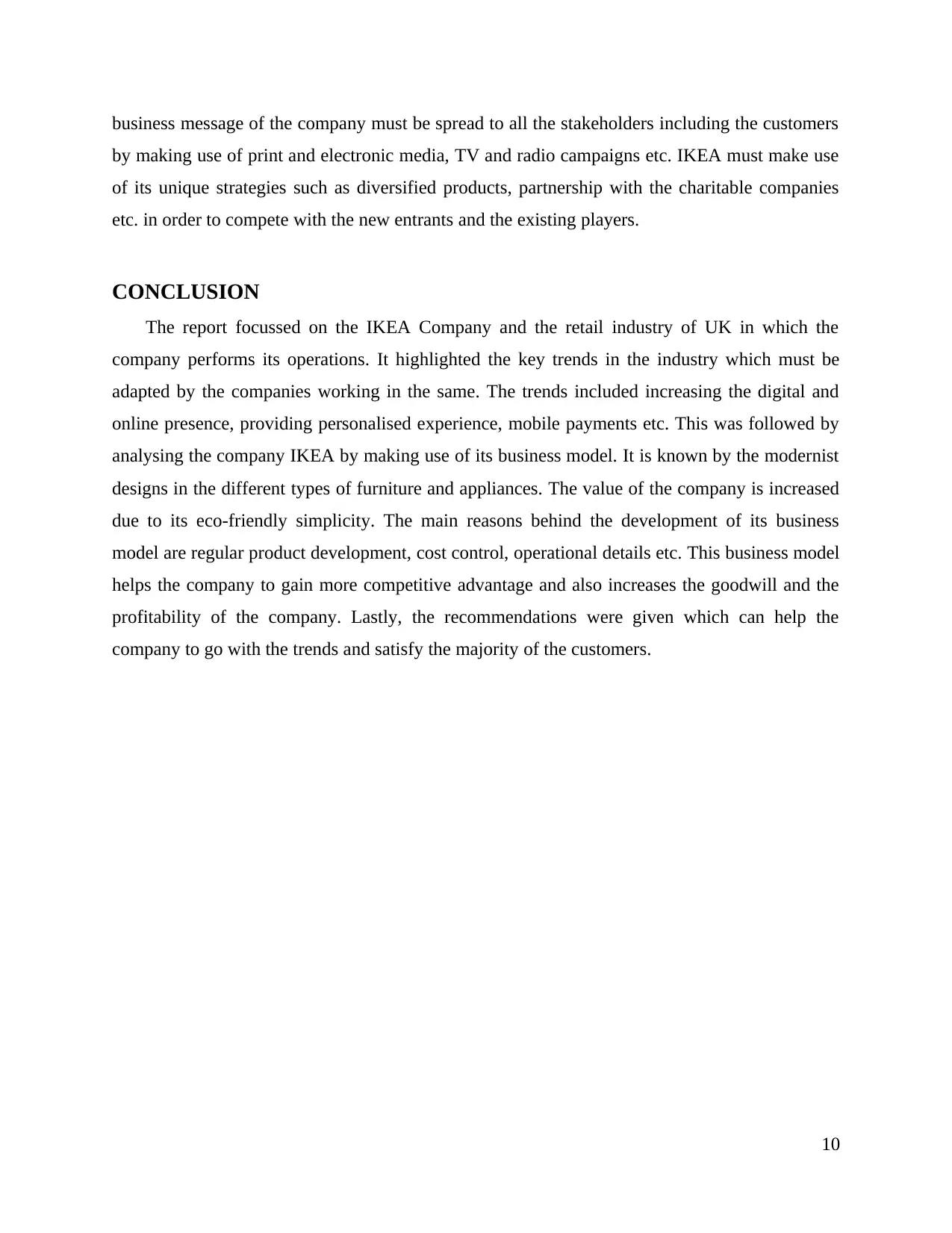
business message of the company must be spread to all the stakeholders including the customers
by making use of print and electronic media, TV and radio campaigns etc. IKEA must make use
of its unique strategies such as diversified products, partnership with the charitable companies
etc. in order to compete with the new entrants and the existing players.
CONCLUSION
The report focussed on the IKEA Company and the retail industry of UK in which the
company performs its operations. It highlighted the key trends in the industry which must be
adapted by the companies working in the same. The trends included increasing the digital and
online presence, providing personalised experience, mobile payments etc. This was followed by
analysing the company IKEA by making use of its business model. It is known by the modernist
designs in the different types of furniture and appliances. The value of the company is increased
due to its eco-friendly simplicity. The main reasons behind the development of its business
model are regular product development, cost control, operational details etc. This business model
helps the company to gain more competitive advantage and also increases the goodwill and the
profitability of the company. Lastly, the recommendations were given which can help the
company to go with the trends and satisfy the majority of the customers.
10
by making use of print and electronic media, TV and radio campaigns etc. IKEA must make use
of its unique strategies such as diversified products, partnership with the charitable companies
etc. in order to compete with the new entrants and the existing players.
CONCLUSION
The report focussed on the IKEA Company and the retail industry of UK in which the
company performs its operations. It highlighted the key trends in the industry which must be
adapted by the companies working in the same. The trends included increasing the digital and
online presence, providing personalised experience, mobile payments etc. This was followed by
analysing the company IKEA by making use of its business model. It is known by the modernist
designs in the different types of furniture and appliances. The value of the company is increased
due to its eco-friendly simplicity. The main reasons behind the development of its business
model are regular product development, cost control, operational details etc. This business model
helps the company to gain more competitive advantage and also increases the goodwill and the
profitability of the company. Lastly, the recommendations were given which can help the
company to go with the trends and satisfy the majority of the customers.
10
Paraphrase This Document
Need a fresh take? Get an instant paraphrase of this document with our AI Paraphraser
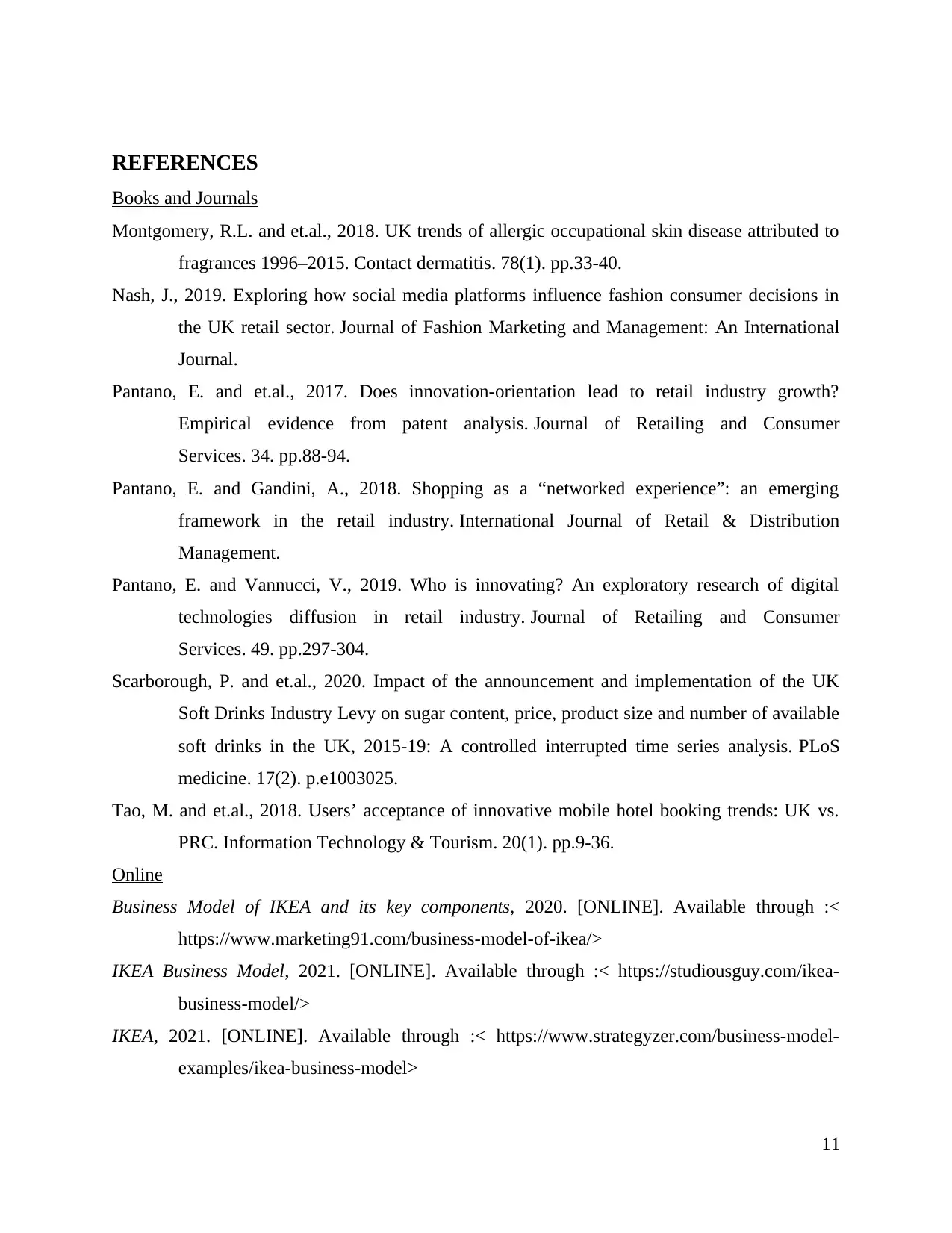
REFERENCES
Books and Journals
Montgomery, R.L. and et.al., 2018. UK trends of allergic occupational skin disease attributed to
fragrances 1996–2015. Contact dermatitis. 78(1). pp.33-40.
Nash, J., 2019. Exploring how social media platforms influence fashion consumer decisions in
the UK retail sector. Journal of Fashion Marketing and Management: An International
Journal.
Pantano, E. and et.al., 2017. Does innovation-orientation lead to retail industry growth?
Empirical evidence from patent analysis. Journal of Retailing and Consumer
Services. 34. pp.88-94.
Pantano, E. and Gandini, A., 2018. Shopping as a “networked experience”: an emerging
framework in the retail industry. International Journal of Retail & Distribution
Management.
Pantano, E. and Vannucci, V., 2019. Who is innovating? An exploratory research of digital
technologies diffusion in retail industry. Journal of Retailing and Consumer
Services. 49. pp.297-304.
Scarborough, P. and et.al., 2020. Impact of the announcement and implementation of the UK
Soft Drinks Industry Levy on sugar content, price, product size and number of available
soft drinks in the UK, 2015-19: A controlled interrupted time series analysis. PLoS
medicine. 17(2). p.e1003025.
Tao, M. and et.al., 2018. Users’ acceptance of innovative mobile hotel booking trends: UK vs.
PRC. Information Technology & Tourism. 20(1). pp.9-36.
Online
Business Model of IKEA and its key components, 2020. [ONLINE]. Available through :<
https://www.marketing91.com/business-model-of-ikea/>
IKEA Business Model, 2021. [ONLINE]. Available through :< https://studiousguy.com/ikea-
business-model/>
IKEA, 2021. [ONLINE]. Available through :< https://www.strategyzer.com/business-model-
examples/ikea-business-model>
11
Books and Journals
Montgomery, R.L. and et.al., 2018. UK trends of allergic occupational skin disease attributed to
fragrances 1996–2015. Contact dermatitis. 78(1). pp.33-40.
Nash, J., 2019. Exploring how social media platforms influence fashion consumer decisions in
the UK retail sector. Journal of Fashion Marketing and Management: An International
Journal.
Pantano, E. and et.al., 2017. Does innovation-orientation lead to retail industry growth?
Empirical evidence from patent analysis. Journal of Retailing and Consumer
Services. 34. pp.88-94.
Pantano, E. and Gandini, A., 2018. Shopping as a “networked experience”: an emerging
framework in the retail industry. International Journal of Retail & Distribution
Management.
Pantano, E. and Vannucci, V., 2019. Who is innovating? An exploratory research of digital
technologies diffusion in retail industry. Journal of Retailing and Consumer
Services. 49. pp.297-304.
Scarborough, P. and et.al., 2020. Impact of the announcement and implementation of the UK
Soft Drinks Industry Levy on sugar content, price, product size and number of available
soft drinks in the UK, 2015-19: A controlled interrupted time series analysis. PLoS
medicine. 17(2). p.e1003025.
Tao, M. and et.al., 2018. Users’ acceptance of innovative mobile hotel booking trends: UK vs.
PRC. Information Technology & Tourism. 20(1). pp.9-36.
Online
Business Model of IKEA and its key components, 2020. [ONLINE]. Available through :<
https://www.marketing91.com/business-model-of-ikea/>
IKEA Business Model, 2021. [ONLINE]. Available through :< https://studiousguy.com/ikea-
business-model/>
IKEA, 2021. [ONLINE]. Available through :< https://www.strategyzer.com/business-model-
examples/ikea-business-model>
11
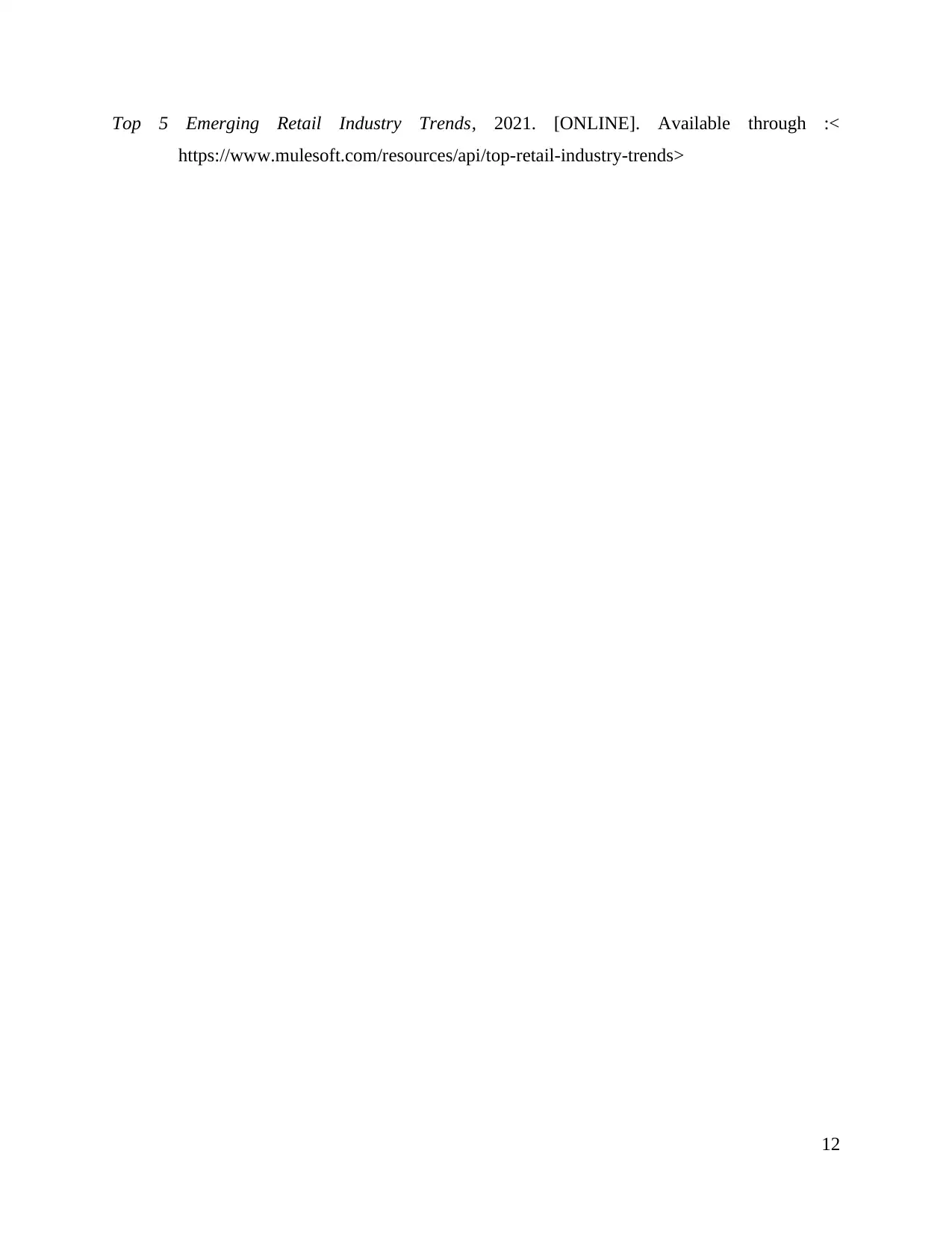
Top 5 Emerging Retail Industry Trends, 2021. [ONLINE]. Available through :<
https://www.mulesoft.com/resources/api/top-retail-industry-trends>
12
https://www.mulesoft.com/resources/api/top-retail-industry-trends>
12
⊘ This is a preview!⊘
Do you want full access?
Subscribe today to unlock all pages.

Trusted by 1+ million students worldwide
1 out of 12
Related Documents
Your All-in-One AI-Powered Toolkit for Academic Success.
+13062052269
info@desklib.com
Available 24*7 on WhatsApp / Email
![[object Object]](/_next/static/media/star-bottom.7253800d.svg)
Unlock your academic potential
Copyright © 2020–2025 A2Z Services. All Rights Reserved. Developed and managed by ZUCOL.





